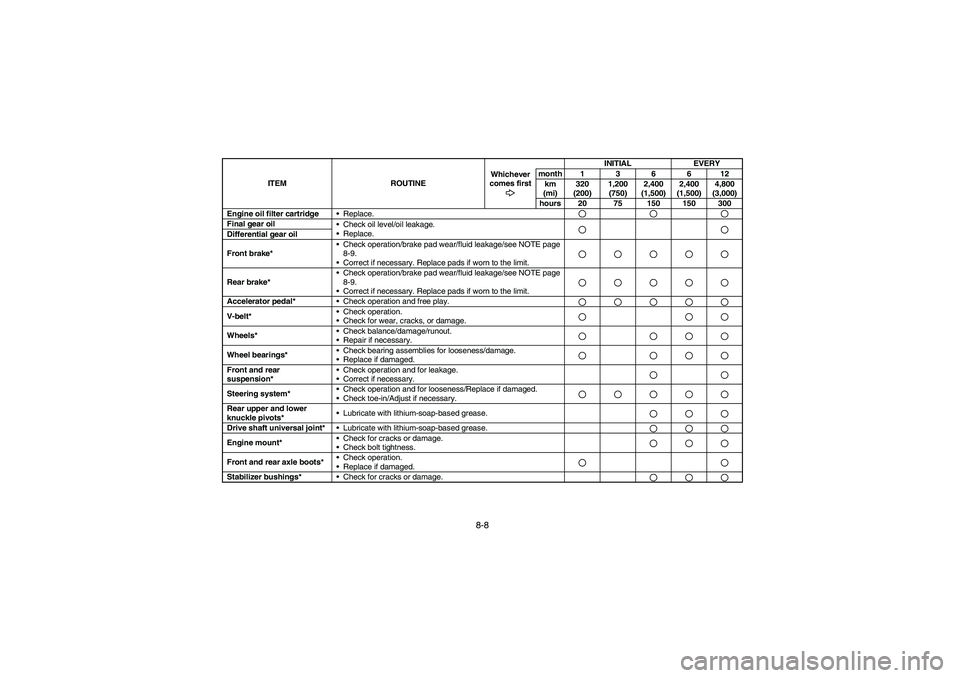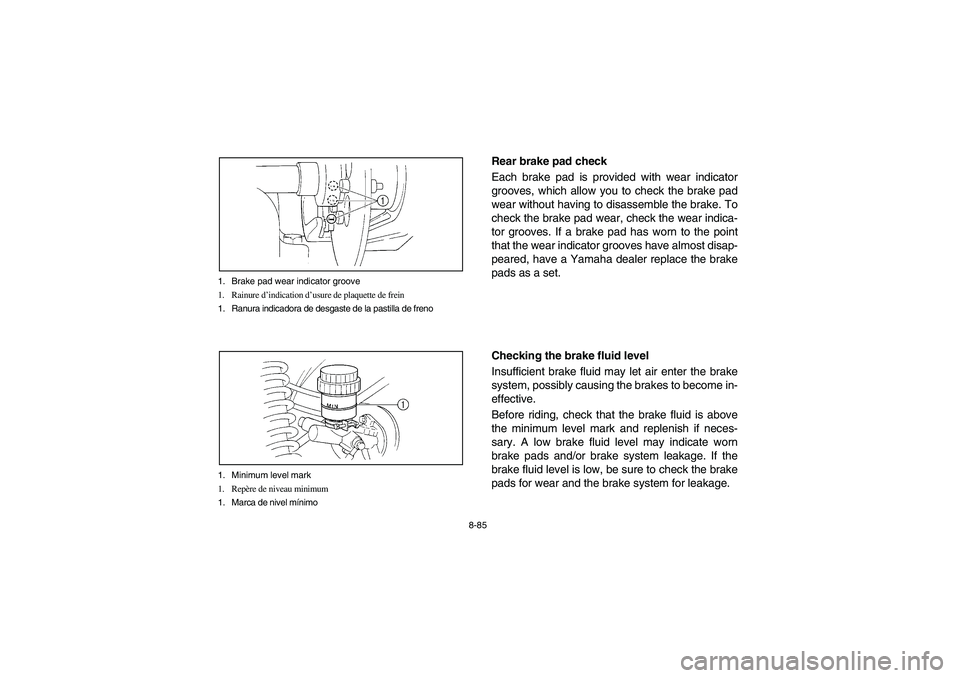Page 224 of 408
7-23
WARNING
Going down a hill improperly could cause loss
of control or cause the vehicle to overturn.�
Always check the terrain carefully before
you start down any hill.
�
Never go down a hill at high speed.
�
Avoid going down a hill at an angle that
would cause the vehicle to lean sharply to
one side. Go straight down the hill where
possible.
Before starting down hill, make sure the vehicle is
in low-range 4WD. On most slopes, this will let you
use engine braking to help you go downhill slowly.
Go as slowly as possible. If you are starting to go
too fast, apply the brakes gently. Avoid sudden ap-
plication of the brakes, which could cause the ve-
hicle to start sliding.
If you are sliding or skidding, try to steer in the di-
rection the vehicle is sliding to help you regain con-
trol.
U5UG61.book Page 23 Monday, September 6, 2004 9:00 AM
Page 228 of 408
7-27
CROSSING THROUGH SHALLOW WATER
If you must cross shallow, slow moving water up to
the depth of the vehicle’s floorboards, choose your
path carefully to avoid sharp drop-offs, large rocks,
or slippery surfaces that could cause the vehicle to
overturn. Never operate through water deeper
than 33 cm (13 in) or fast flowing water.
Wet brakes may have reduced effectiveness. After
leaving the water, test your brakes. If necessary,
apply the brakes several times to let friction dry out
the linings.
WARNING
Never operate this vehicle in fast-flowing water
or in water deeper than 33 cm (13 in). This
could result in a loss of control and an acci-
dent, including a overturn, which could in-
crease the risk of drowning. Remember that
wet brakes may have reduced stopping ability.
Test your brakes after leaving water. If neces-
sary, apply them several times to let friction
dry out the linings.
U5UG61.book Page 27 Monday, September 6, 2004 9:00 AM
Page 238 of 408
7-37
ENCOUNTERING OBSTACLES ON THE TRAIL
If you cannot go around an obstacle such as a fall-
en tree trunk or a ditch, stop the vehicle where it is
safe to do so. Set the parking brake and get out to
inspect the area thoroughly. Look from both your
approach side and the exit side. If you believe you
can continue safely, decide the path that will allow
you to get over the obstacle at as close to a right
angle as possible to minimize vehicle tipping. Go
only fast enough to maintain your momentum but
still give yourself plenty of time to react to changes
in conditions. If there is any question about your
ability to maneuver safely over the obstacle, you
should turn around, if the ground is flat and you
have the room, or back up until you find a less dif-
ficult path.
WARNING
Before operating in a new area, check for ob-
stacles. Use extreme caution when operating
over large obstacles, such as large rocks or
fallen trees.
U5UG61.book Page 37 Monday, September 6, 2004 9:00 AM
Page 247 of 408

8-8
Engine oil filter cartridge
Replace.Final gear oil
Check oil level/oil leakage.
Replace.Differential gear oil
Front brake*Check operation/brake pad wear/fluid leakage/see NOTE page
8-9.
Correct if necessary. Replace pads if worn to the limit.Rear brake*Check operation/brake pad wear/fluid leakage/see NOTE page
8-9.
Correct if necessary. Replace pads if worn to the limit.Accelerator pedal*
Check operation and free play.V-belt*Check operation.
Check for wear, cracks, or damage.Wheels*Check balance/damage/runout.
Repair if necessary.Wheel bearings*Check bearing assemblies for looseness/damage.
Replace if damaged.Front and rear
suspension*Check operation and for leakage.
Correct if necessary.Steering system*Check operation and for looseness/Replace if damaged.
Check toe-in/Adjust if necessary.Rear upper and lower
knuckle pivots*Lubricate with lithium-soap-based grease.Drive shaft universal joint*
Lubricate with lithium-soap-based grease.Engine mount*Check for cracks or damage.
Check bolt tightness.Front and rear axle boots*Check operation.
Replace if damaged.Stabilizer bushings*
Check for cracks or damage.
ITEM ROUTINEWhichever
comes firstINITIAL EVERY
month136612
km
(mi)320
(200)1,200
(750)2,400
(1,500)2,400
(1,500)4,800
(3,000)
hours 20 75 150 150 300
U5UG61.book Page 8 Monday, September 6, 2004 9:00 AM
Page 248 of 408
8-9
* Since these items require special tools, data and technical skills have a Yamaha dealer perform the service.NOTE:�
Recommended brake fluid: DOT 4
�
Brake fluid replacement:
When disassembling the master cylinder or caliper, replace the brake fluid. Normally check the
brake fluid level and add fluid as required.
On the inner parts of the master cylinder and caliper, replace the oil seals every two years.
Replace the brake hoses every four years, or if cracked or damaged.
Fittings and fasteners*Check all chassis fittings and fasteners.
Correct if necessary.
ITEM ROUTINEWhichever
comes firstINITIAL EVERY
month136612
km
(mi)320
(200)1,200
(750)2,400
(1,500)2,400
(1,500)4,800
(3,000)
hours 20 75 150 150 300
U5UG61.book Page 9 Monday, September 6, 2004 9:00 AM
Page 260 of 408
8-21 1. Console
1. Console
1. Consola
EVU00691
Console
To remove
1. Remove the seats. (See page 4-43 for seat
removal and installation procedures.)
2. Remove the parking brake lever boot.
3. Pull the console upward (the drive select le-
ver boot will come loose).
To install
1. Place the console in its original position.
2. Install the parking brake lever boot.
3. Install the seats.CAUTION:_ �
When installing the console, be sure not to
pinch the cables or wires.
�
Make sure that the groove at the bottom of
the parking brake lever boot and the drive
select lever boot fits securely around the
edge of the hole in the console.
_
U5UG61.book Page 21 Monday, September 6, 2004 9:00 AM
Page 322 of 408
8-83 1. Brake pad wear indicator groove
1. Rainure d’indication d’usure de plaquette de frein
1. Ranura indicadora de desgaste de la pastilla de freno
EVU00830
Front brake pad check
Each brake pad is provided with wear indicator
grooves, which allow you to check the brake pad
wear without having to disassemble the brake. To
check the brake pad wear, check the wear indica-
tor grooves. If a brake pad has worn to the point
that the wear indicator grooves have almost disap-
peared, have a Yamaha dealer replace the brake
pads as a set.NOTE:_ The wheels need to be removed to check the
brake pads. (See pages 8-103–8-105 for wheel re-
moval and installation procedures.) _
U5UG61.book Page 83 Monday, September 6, 2004 9:00 AM
Page 324 of 408

8-85 1. Brake pad wear indicator groove
1. Rainure d’indication d’usure de plaquette de frein
1. Ranura indicadora de desgaste de la pastilla de freno
1. Minimum level mark
1. Repère de niveau minimum
1. Marca de nivel mínimo
EVU00840
Rear brake pad check
Each brake pad is provided with wear indicator
grooves, which allow you to check the brake pad
wear without having to disassemble the brake. To
check the brake pad wear, check the wear indica-
tor grooves. If a brake pad has worn to the point
that the wear indicator grooves have almost disap-
peared, have a Yamaha dealer replace the brake
pads as a set.
EVU00850
Checking the brake fluid level
Insufficient brake fluid may let air enter the brake
system, possibly causing the brakes to become in-
effective.
Before riding, check that the brake fluid is above
the minimum level mark and replenish if neces-
sary. A low brake fluid level may indicate worn
brake pads and/or brake system leakage. If the
brake fluid level is low, be sure to check the brake
pads for wear and the brake system for leakage.
U5UG61.book Page 85 Monday, September 6, 2004 9:00 AM